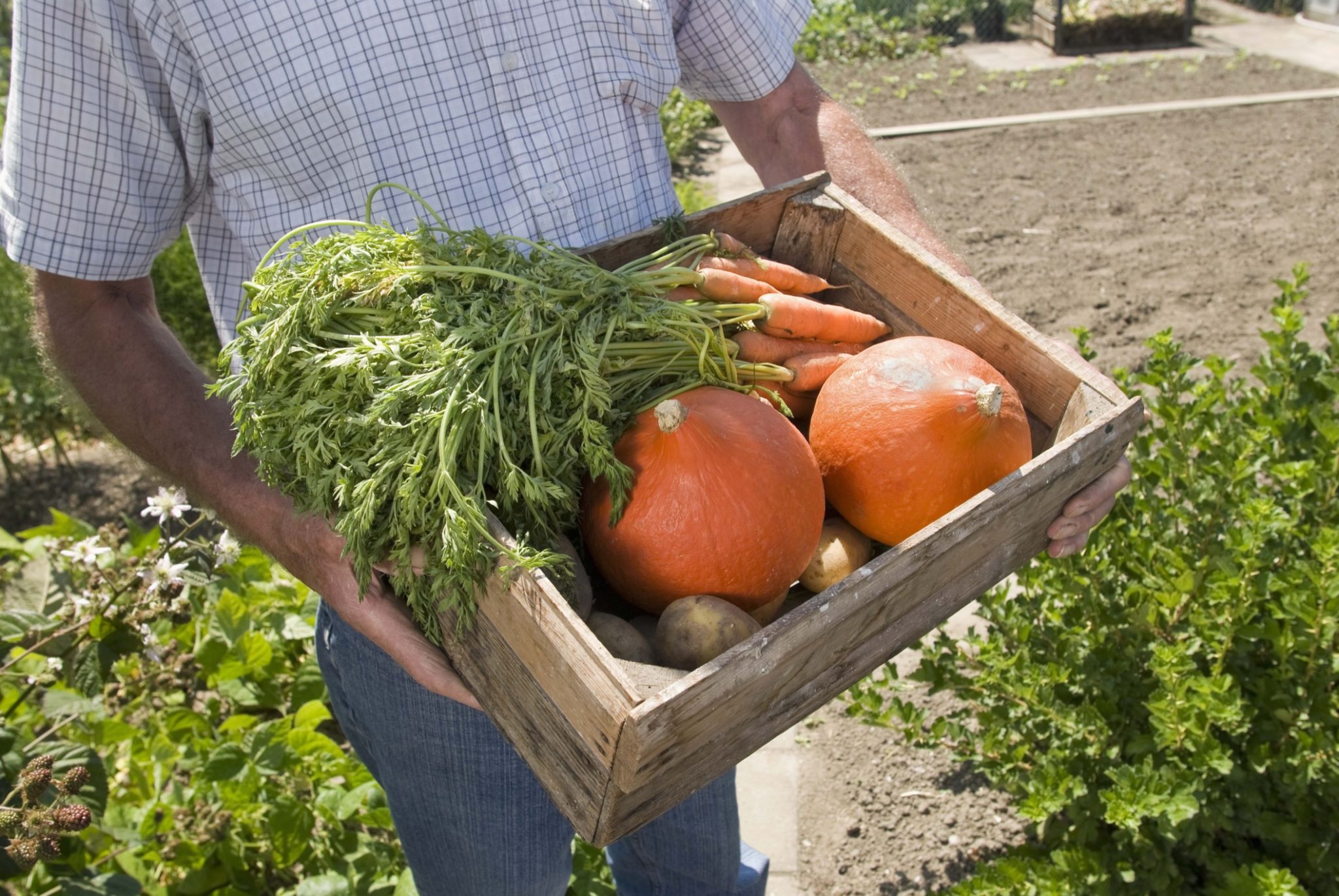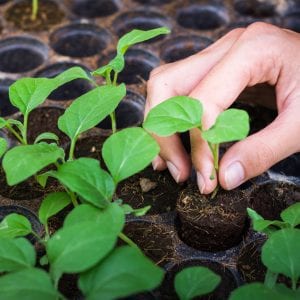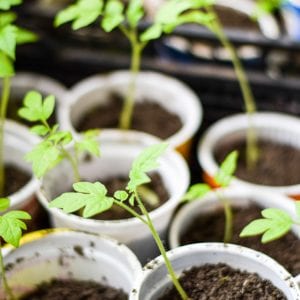Vegetables

There are a number of considerations to be made when preparing to grow vegetable transplants for your home garden, including sowing the seeds or selecting the plants, preparing the growing media, and selecting the type of container to start them in as well as how to care for the plants until they are ready to be placed into your garden.
If purchasing plants, choose medium-sized plants that have a stocky, healthy appearance and deep green color and are free from insects and diseases. The best plants are not necessarily the largest or the tallest. For example, avoid tomato plants that have flowers or fruits on them because the presence of flowers and fruits indicates that the plant is growing under stressful conditions. The plants are likely root-bound as well. All of this adds up to a plant that will perform poorly or if it survives transplanting, it will not produce much, if any, fruit.
Growing Media
One of the most important considerations in growing vegetable transplants for your home garden is the media they are to be grown in and the preparation thereof. A growing mix well suited for transplants can be prepared by using one part loamy garden soil, one part shredded peat moss, and one part sand. After it is mixed, the media should be sterilized to prevent seedlings from being killed by the fungi that cause damping-off diseases. To sterilize the soil-peat-sand mix, bake it in an oven for about 1 hour at 210 degrees F.
Growing media can also be purchased at a local garden center or from a seed and garden supply catalog. The most widely available and relatively inexpensive seed-starting medium is vermiculite. Seedlings cannot be grown in vermiculite for very long, however, because there are no nutrients in it. Seedlings grown in vermiculite must be given a water-soluble fertilizer regularly or be transplanted to sterile soil when the second pair of true leaves form. Vermiculite does not need to be sterilized because it is already sterile when purchased.
The easiest method is to purchase a seedling mix, which is typically composed of vermiculite and peat moss. These mixes are suited for more long term transplant production (4 to 10 weeks) and generally contain enough nutrients to provide nutrition to the developing seedling for up to two weeks. After two weeks, you need to provide nutrients (see below).
Containers
Many containers are suitable for sowing seeds. Wooden flats and plastic trays are recommended if you want to start a large number of seedlings in a limited work area because they take up less space than individual pots do. Other commonly used transplant containers are pots made of compressed peat, disks of pressed peat that swell to potlike cylinders when soaked in water, and peat cubes. Some of the simplest containers for starting seeds can be found right in your kitchen. Aluminum foil frozen-food trays are among the best, but cottage cheese dishes, bottom halves of milk cartons, ice cream cartons, egg cartons, and paper cups are handy starter containers. Any of these containers must be clean, sturdy, and fit into the space available for growing plants in the home, and all must have drainage holes to allow excess water to
run off.
Location
Once the seeds have emerged from the media that they are planted in, they must be given sufficient sunlight to ensure the development of healthy, stocky plants. The ideal location is on a sun porch or in a window with southern exposure. If bright sunlight is not available, an alternative is to use fluorescent lights. A fixture containing two 40-watt, cool-white fluorescent or grow-light tubes spaced 3 to 4 inches apart is sufficient. Place seedlings about 6 to 8 inches from the tubes, and leave the light on for 14 to 16 hours each day. Raise the lights as the plants grow to prevent leafburn as the plants grow.
In addition to providing sufficient light, the growing area must be warm. Generally, the temperature should be between 60 and 65 degrees F at night and 70 and 75 degrees F during the day. Certain vegetable transplants, however, grow better at different temperatures, (table 1). When growing a variety of vegetables, provide the minimum ideal temperatures needed by the vegetable requiring the highest temperature.
Watering and Fertilizing
Check plants daily to make sure the media is moist. Water the plants if the media feels dry to the touch, but be sure to check the media daily. Overwatering as well as underwatering are detrimental and can cause damping-off, a disease of seedlings caused by fungi.
The first fertilization should be done a few days after the seedlings have emerged. Use a water-soluble fertilizer garden centers. The first application of fertilizer should be applied at half the strength of the manufacturer’s recommendation. Depending on the fertilizer used, about 1 to 2 teaspoons per gallon of water applied once every week should be adequate. If the seedlings begin to look yellow and thin, use more fertilizer; if the seedlings are growing too fast and too large, fertilize them less often.
Hardening Off
Before being set into the garden, the plants should be hardened off, which is the process whereby plant tissues are toughened to withstand the outside environment. Over a 2-week period, set the plants outside in day, and then bring them back in at night. Leave the transplants outside for a longer period of time each day during the hardening-off period so they become accustomed to being outdoors. Take appropriate precautions, however, so the transplants are not killed by frost. Transplants purchased from garden centers, etc. are usually hardening-off and can be placed directly in the garden.
Table 1. Temperatures and Times Required to Grow Transplants for Your Garden
| Vegetable | Day (ºF) | Night (ºF) | Time (Weeks) |
|---|---|---|---|
| Asparagus | 70 - 80 | 65 - 70 | 8 - 10 |
| Broccoli | 60 - 70 | 50 - 60 | 5 - 7 |
| Brussels sprouts | 60 - 70 | 50 - 60 | 5 - 7 |
| Cabbage | 60 - 70 | 50 - 60 | 5 - 7 |
| Cauliflower | 60 - 70 | 50 - 60 | 5 - 7 |
| Sweet corn | 70 - 75 | 60 - 65 | 3 - 4 |
| Cucumber | 70 - 75 | 60 - 65 | 3 - 4 |
| Eggplant | 70 - 80 | 65 - 70 | 6 - 8 |
| Lettuce | 55 - 65 | 50 - 55 | 5 - 7 |
| Muskmelon | 70 - 75 | 60 - 65 | 3 - 4 |
| Onion | 60 - 65 | 55 - 60 | 10 - 12 |
| Pepper | 65 - 75 | 60 - 65 | 6 - 8 |
| Summer squash | 70 - 75 | 60 - 65 | 3 - 4 |
| Tomato | 65 - 75 | 60 - 65 | 5 - 7 |
| Watermelon | 70 - 80 | 65 - 70 | 3 - 4 |
Download a PDF of Keys to Producing and Selecting Quality Vegetable Transplants, ANR-1423.



